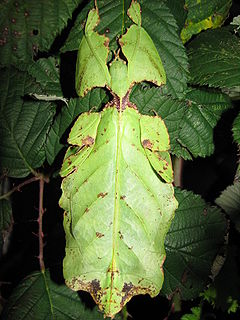
The Phasmatodea are an order of insects whose members are variously known as stick insects, stick-bugs, walking sticks, or bug sticks. They are generally referred to as phasmatodeans, phasmids, or ghost insects. Phasmids in the family Phylliidae are called leaf insects, leaf-bugs, walking leaves, or bug leaves. The group's name is derived from the Ancient Greek φάσμα phasma, meaning an apparition or phantom, referring to their resemblance to vegetation while in fact being animals. Their natural camouflage makes them difficult for predators to detect; still, many species have one of several secondary lines of defence in the form of startle displays, spines or toxic secretions. Stick insects from the genera Phryganistria, Ctenomorpha, and Phobaeticus includes the world's longest insects.

Timema is a genus of relatively short-bodied, stout stick insects native to the far western United States, and the sole extant member of the family Timematidae. The genus was first described in 1895 by Samuel Hubbard Scudder, based on observations of the species Timema californicum.

Phyllium giganteum, commonly known as the Giant Malaysian Leaf insect, is a species of leaf-insect described from Malaysia by Hausleithner in 1984 and placed in the genus Phyllium and family Phylliidae. Phyllium giganteum are the largest species belonging to the genus Phyllium reaching 105mm in size. They are found most abundantly in the west Malaysian tropics. The females typically have large elytra that lie edge to edge on the abdomen and tend to lack hind wings making them usually flightless. Males have small elytra and sometimes transparent non-leaflike functional hind wings. Phyllium giganteum found in the wild tend to be mostly females and the first male of this species was not found until 1994. In captivity, the species has primarily been observed to reproduce through parthenogenesis meaning the females are asexual. The primary reproductive pattern in the wild is unknown. Eggs tend to be brown or black and glossy and resemble the look of seeds. They hatch around 6 months after breeding. Newly hatched young nymphs tend to be wingless and brown or reddish in color. They develop their green color after feeding on leaves. Both the adult and larval stages are phytophagous meaning they feed on plants. The main plant food sources for this species are oak and bramble tree leaves.

Sceptrophasma hispidulum, commonly known as the Andaman Islands stick insect, is a species of the stick insect family. It originates from the Andaman Islands and is commonly found in tropical forests there. They eat a variety of foliage, though in captivity they commonly eat blackberry bramble, hawthorn, oak, rose, and lettuce. The species has the Phasmid Study Group number PSG183.

Diapheromera arizonensis, the Arizona walkingstick, is a species of walkingstick in the family Diapheromeridae. It is found in North America.

Parabacillus hesperus, the western short-horn walkingstick, is a species of walkingstick in the family Heteronemiidae. It is found in North America. This species is found in dry, arid in the summer and fall. Their diet consists of various scrub and grassland plants. Through an adaptation called "crypsis," it blends in so perfectly with its natural habitat that it often goes completely undetected by would-be predators.

Timema poppense, the "Pope Valley timema", is a species of walkingstick in the family Timematidae. It is found in California, and originally described from a nature reserve in the Pope Valley.

Diapheromera is a genus of stick insects in the family Diapheromeridae. There are about 14 described species in Diapheromera.

Parabacillus is a genus of short-horn walkingsticks in the family Heteronemiidae. There are at least three described species in Parabacillus.

Heteronemiidae is a family of walkingsticks in the order Phasmatodea. There are about 14 genera and at least 80 described species in Heteronemiidae.
Canuleius is a genus of walkingsticks in the family Heteronemiidae. There are at least 20 described species in Canuleius.

Aschiphasmatidae are a family of stick insects belonging to the suborder Verophasmatodea; they can be found in Indomalaya.
Timema ritense, the Santa Rita timema, is a species of walkingstick in the family Timematidae. It is found in North America. The species was originally spelled "ritensis", but this spelling did not match the gender of the genus Timema, and therefore has undergone a mandatory change following ICZN Article 31.2.

Diapheromerini is a tribe of walkingsticks in the family Diapheromeridae. There are at least 30 genera Diapheromerini.
Timema nevadense, the Nevada timema, is a species of walkingstick in the family Timematidae. It is found in North America.
Anisacanthidae is a family of walkingsticks in the order Phasmatodea. There are about 10 genera and at least 30 described species in Anisacanthidae.
Damasippoididae is a family of walkingsticks in the order Phasmatodea. There are at least two genera and about six described species in Damasippoididae, found in Madagascar.

Timema genevievae, or Genevieve's timema, is a species of walkingstick in the family Timematidae. It is found in North America.

Timema californicum, the California timema, is a species of walkingstick in the family Timematidae. It is found in North America.
Timema boharti, or Bohart's timema, is a species of walkingstick in the family Timematidae. It is found in North America.










